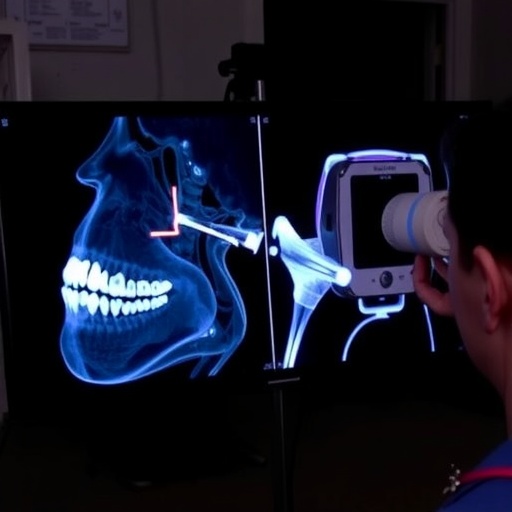In an era where advanced imaging techniques are revolutionizing the field of pediatric medicine, a groundbreaking study has emerged that sheds light on the intricacies of the pediatric hyoid-larynx complex. Authored by a team of researchers including Timmerman, Van Goethem, and Docter, this pivotal study utilizes micro-computed tomography (micro-CT) to explore this complex area of human anatomy in children. The implications of this research could be far-reaching, offering insights that may enhance our understanding of various pediatric conditions affecting respiratory function and swallowing.
Micro-computed tomography is a sophisticated imaging modality that provides high-resolution three-dimensional (3D) images of biological specimens. This technology has gained traction in the medical community, particularly in fields requiring detailed anatomical visualization. The traditional imaging techniques often fall short when it comes to resolving the fine structural details of small anatomical features. Micro-CT addresses this limitation, allowing researchers to see what was previously obscured by the constraints of conventional imaging methods.
The hyoid-larynx complex plays a vital role in several fundamental functions, including phonation, airway protection, and the swallowing process. Understanding the anatomical variations within this complex in pediatric populations is critical for addressing various clinical challenges such as airway obstruction, speech disorders, and swallowing difficulties. The study by Timmerman and colleagues specifically targets these issues, positing that advanced imaging techniques like micro-CT can reveal subtle morphological differences crucial for effective diagnosis and treatment.
One of the most notable aspects of this study is its focus on pediatric patients, a demographic often overlooked in anatomical and clinical studies. Children’s anatomical structures differ significantly from those of adults, which can complicate the diagnosis and treatment of conditions affecting the hyoid-larynx complex. The researchers underscore that comprehensive knowledge of these differences can directly influence clinical outcomes, paving the way for personalized medical approaches tailored to the needs of younger patients.
By employing micro-CT, the researchers were able to visualize the hyoid-larynx complex with unparalleled clarity. This method generates images that not only display the external morphology but also unveil the intricate internal structures. Such detailed imaging is invaluable for clinicians seeking to understand the etiology of various pediatric conditions that could range from congenital deformities to acquired pathologies. The study meticulously documents the specific imaging techniques and protocols utilized, providing a blueprint for future research endeavors in this arena.
The data collected through this study also holds the potential to elevate the field of pediatric otolaryngology significantly. As researchers continue to investigate the implications of hyoid-larynx anatomy on clinical outcomes, the integration of micro-CT findings could lead to refined surgical techniques and improved preoperative planning. By harnessing the power of micro-CT imaging, clinicians will be better equipped to diagnose conditions that may have previously eluded identification due to the complexities involved.
Additionally, the implications of this research extend beyond immediate clinical applications. The findings could potentially influence educational curricula for medical students and residents specializing in pediatrics and otolaryngology. By integrating cutting-edge imaging studies into their training, future clinicians will possess a more comprehensive understanding of pediatric anatomy and pathology, enhancing their diagnostic acumen and treatment strategies.
Moreover, the study’s outcomes invite further exploration into the association between anatomical variations in the hyoid-larynx complex and common pediatric disorders. Conditions such as obstructive sleep apnea, dysphagia, and laryngeal malformations could be better understood through the lens of this advanced imaging technique. By establishing a database of anatomical variations in healthy pediatric patients, clinicians can create a valuable reference that can guide future interventions.
Despite the promising advantages of micro-CT, the study does raise ethical considerations concerning its application in routine clinical practice. The necessity of ensuring patient safety and minimizing radiation exposure is paramount, particularly in a pediatric population that is more vulnerable. The research team addresses these concerns, advocating for careful consideration of the risks and benefits of employing micro-CT in clinical settings, ensuring that its advantages outweigh potential hazards.
As researchers continue to delve deeper into the anatomical complexities of the pediatric hyoid-larynx complex, it is essential to recognize the collaborative efforts required to propel this field forward. Interdisciplinary cooperation among radiologists, pediatricians, and otolaryngologists will be crucial in maximizing the benefits that advanced imaging technologies can provide. By working together, these specialists can foster an environment of knowledge sharing that ultimately enhances patient care.
The anticipation surrounding the publication of this study highlights a growing interest in the role of advanced imaging modalities in pediatric medicine. As micro-CT technology continues to evolve, the possibilities for enhancing our understanding of pediatric anatomy and pathology appear boundless. The innovative applications for this imaging technique will likely inspire a new wave of research, contributing to improved outcomes for children facing a variety of health challenges.
In conclusion, this study not only highlights a significant advancement in imaging technology but also emphasizes the critical importance of understanding pediatric anatomy in clinical practice. The potential for micro-CT to reshape our approach to diagnosing and treating conditions affecting the hyoid-larynx complex cannot be overstated. As the medical community continues to embrace innovative technologies, the hope is that pediatric patients will ultimately receive the comprehensive care they deserve.
In a world increasingly reliant on technology to enhance medical practice, the ongoing exploration of micro-CT within the context of pediatric health care promises to unveil new knowledge and illuminate pathways for improved patient outcomes. As researchers like Timmerman, Van Goethem, and Docter lead the way, the future of pediatric imaging and its contributions to clinical practices looks remarkably promising.
Subject of Research: Pediatric hyoid-larynx complex
Article Title: Evaluating micro-computed tomography for investigation of the pediatric hyoid-larynx complex
Article References:
Timmerman, G., Van Goethem, A., Docter, D. et al. Evaluating micro-computed tomography for investigation of the pediatric hyoid-larynx complex.
Pediatr Radiol (2025). https://doi.org/10.1007/s00247-025-06364-6
Image Credits: AI Generated
DOI: https://doi.org/10.1007/s00247-025-06364-6
Keywords: micro-computed tomography, pediatric anatomy, hyoid-larynx complex, advanced imaging, pediatric health care.




